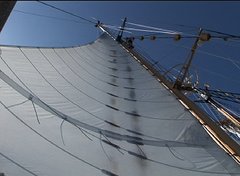 |
| Chris at the helm as Seamans steers toward a squall line. |
Moorea, where many of us spent a few days before embarking, did not appease many fears. The first thing I did was to throw on a snorkel and swim onto the reef directly out the back door of the Airbnb where we stayed. The water was cloudy. Besides some sea cucumbers, mostly devoid of life. A few coral heads stood amid clumps of turf algae smothering the dismembered remains of once regal branching corals. As I swam through this seafloor graveyard, I almost caught myself on a gillnet in which a 5-inch long juvenile parrot fish, the largest fish I had seen that day, struggled to free itself. After that day, I wondered if the other reefs we were to visit on board had suffered a similar fate.
 |
| Bleached corals dotted the reef at Îles Maria. |
On these uninhabited islands the reefs could be unfished, vibrant and healthy or bleached with the symbiotic algae living in corals unable to survive such high water temperatures. With a hesitant anticipation we leaned back off the rescue boat and looked around. Below us the sea floor was tinged pink with coralline algae, corals favorite substrate to grow, and branching corals clamor over each other for space. Looking past the schools of parrotfish however, it was impossible to miss the effects the warming oceans. Some of the coral heads were bright, almost blinding white instead of the kaleidoscope of greens, blues, reds and browns of their neighbors. Bereft of local pressures like overfishing and nutrient pollution, the vast reefs around the Îles Maria are mostly vibrant and healthy. Still, there is no telling how much more time they can survive the global pressures all reefs face like ocean warming and acidification.
From Îles Maria we headed to Rarotonga, the capitol of the Cook Islands. I was excited to see if the reefs were as healthy as those around Îles Maria, or if local pressures had dealt similar damage to those around Moorea. However, getting in the murky water I could barely see anything. In eight spots we surveyed around the island, I could make out more algae than corals in the turbid waters. It seemed to confirm the worst of what we learned in class: The proliferation of algae is thought to be correlated with an increase of development and human sewage seeping into the island waters. Foreign experts had been brought here to offer solutions to the problem. As we set sail from the Cook Islands for Tonga, I wondered if it was ever possible for coral reefs to coexist with the pressures humans place on them.
 |
| Vibrant, healthy corals from the reefs at Vava'u, Tonga. |
All these ideas roiled through my head as I stood at the helm, steering the ship into the dark horizon. As the Seamans drew closer to the ominous front, the clouds began to dissipate. To our left a rainbow emerged, its end dipping below the waves a hundred yards from our port bow. We passed by with barely a sprinkle. A couple of hours later, the sky cleared of clouds, the wind stopped and the ocean surface turned smooth like glass. It was time for an open-ocean swim in waters usually traversed by freighters, deep-sea fishing fleets and historically whalers. We all jumped in the water. During a game of open ocean water polo, Captain Pamela called “Whale Ho!” from the deck. Turning where she pointed I saw the mist from its last blow before diving to great blue depths below. Another hopeful sign of the resilience of the living oceans.
--Chris Le Boa


No comments:
Post a Comment